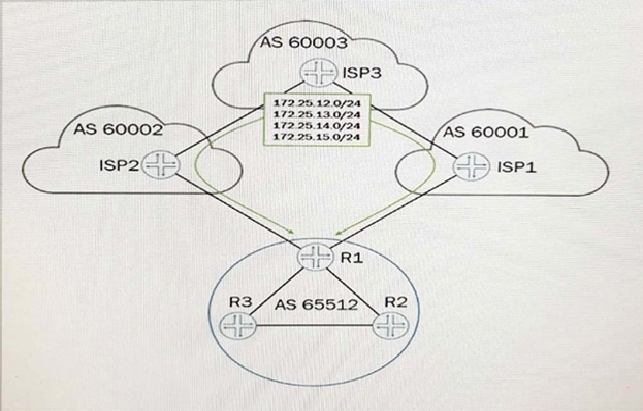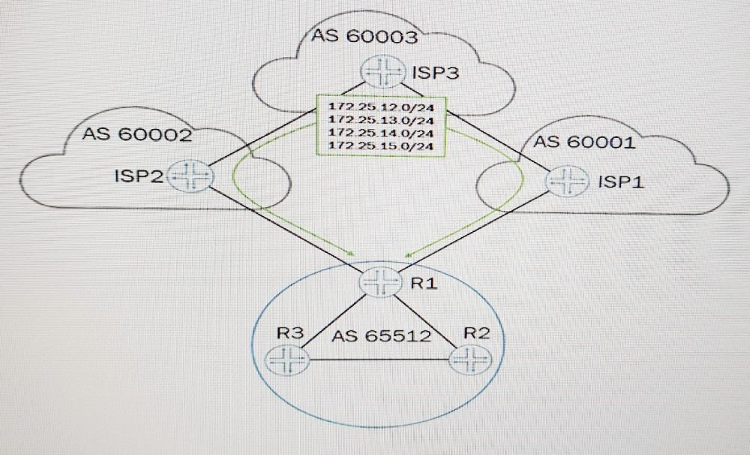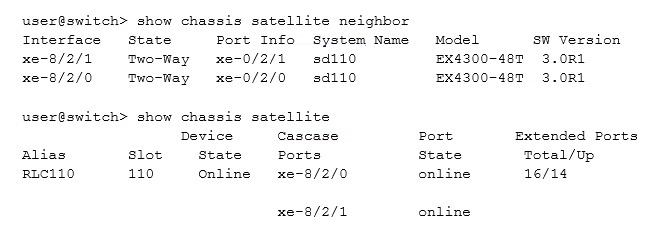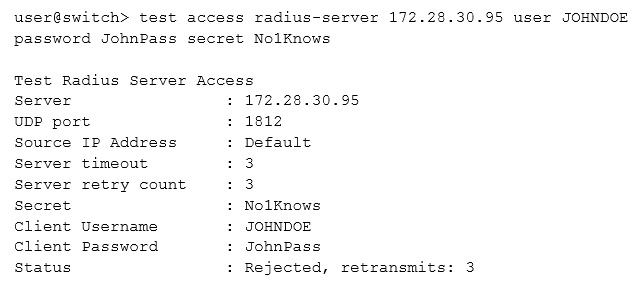Download Enterprise Routing and Switching, Professional (JNCIP-ENT).JN0-647.PracticeTest.2018-06-29.44q.vcex
| Vendor: | Juniper |
| Exam Code: | JN0-647 |
| Exam Name: | Enterprise Routing and Switching, Professional (JNCIP-ENT) |
| Date: | Jun 29, 2018 |
| File Size: | 4 MB |
How to open VCEX files?
Files with VCEX extension can be opened by ProfExam Simulator.
Discount: 20%
Demo Questions
Question 1
Click the Exhibit.

Referring to the exhibit, you have EBGP peerings with both ISP1 and ISP2. You are receiving the 172.25.12.0/24, 172.25.13.0/24, 172.25.14.0/24, and 172.25.15.0/24 routes through both neighbors. You must ensure that traffic to these prefixes are load balances through both service providers. You have configured a load-balancing policy and have applied it to the forwarding table, but the prefixes are not being load balanced.
What is required to accomplish this task?
- The multihop feature should be enabled between both neighbors.
- The multipath multiple-as feature should be used between both neighbors.
- The as-override feature should be used between both neighbors.
- The include-mp-next-hop feature should be used between both neighbors.
Correct answer: B
Question 2
Which protocol is used for port-level access control and authentication?
- MD5
- IPsec
- 802.1X
- AES
Correct answer: C
Question 3
Click the Exhibit.

Referring to the exhibit, you are receiving multiple routes from ISP3 through two EBGP neighbors. You must ensure that all traffic leaving R1 destined to the networks advertised by ISP3 go through ISP2.
What should you do on R1 to accomplish this task?
- Create and apply an import policy to set the local preference on routes learned from ISP2 to be lower than those learned from ISP1.
- Create and apply an import policy to set the route preference on routes learned from ISP2 to be lower than those learned from ISP1.
- Create and apply an import policy to set the route preference on routes learned from ISP2 to be higher than those learned from ISP1.
- Create and apply an import policy to set the local preference on routes learned from ISP2 to be higher than those learned from ISP1.
Correct answer: D
Question 4
Click the Exhibit.

Referring to the exhibit, which two statements are correct? (Choose two.)
- The satellite device has two ports that are not online.
- The satellite device has 14 network-facing ports available.
- The satellite device is in a state of transition.
- The satellite device can support up to 48 total ports.
Correct answer: AD
Question 5
Which two statements are true about 802.1Z dynamic filters based on RADUIS attributes? (Choose two.)
- Filters can be defined on the network management system and deployed using vendor-specific attributes.
- Filters can be defined on the switch and deployed upon authentication.
- Filters can be defined on an automation framework and deployed when triggered by an authentication syslog message.
- Filters can be defined on the authentication server and deployed using vendor-specific attributes.
Correct answer: BD
Question 6
Which protocol is a multicast routing protocol?
- OSPF
- BGP
- PIM
- IS-IS
Correct answer: C
Question 7
You are configuring a scheduler map on an EX9200 Series device. You want to ensure that traffic is dropped in a policing action once traffic exceeds the configured transit rate.
Which configuration parameter will meet this requirement?
- exact
- rate-limit
- remainder
- percent
Correct answer: B
Question 8
Click the Exhibit.

All of the clients attached to your EX4300 report that authentication to the network is abnormally slow. While troubleshooting, you individually test the RADIUS servers used for authentication and receive the information shown in the exhibit.
What happened to the RADIUS server 172.28.30.95?
- The server is no longer reachable.
- The RADIUS daemon went offline.
- There is a RADIUS version mismatch.
- Someone changed the RADIUS secret.
Correct answer: D
Question 9
You are enabling 802.1X authentication on an EX Series device. You are configuring the switch in the conference room where you will have non-employees with devices that do not support 802.1X authentication connecting to your network. You must ensure that these users can connect to your network but are restricted to Internet access only.
What should you do to accomplish this task?
- You must add a RADIUS account for each user and assign them to the appropriate VLAN.
- You should ensure that the server-fail fallback feature is enabled and users are assigned to the appropriate VLAN.
- You should assign a guest VLAN to the interfaces and isolate that VLAN to Internet access only.
- You should configure a server-reject VLAN to the interfaces and isolate that VLAN to Internet access only.
Correct answer: C
Question 10
Which two statements are true about OSPFv3? (Choose two.)
- OSPFv3 packets are sent using local subnet addressing.
- OSPFv3 packets are sent using link local addressing.
- The authentication mechanisms in OSPFv3 are the same mechanisms used in OSPFv2.
- The authentication mechanisms from OSPFv2 are not present in OSPFv3.
Correct answer: BD
HOW TO OPEN VCE FILES
Use VCE Exam Simulator to open VCE files

HOW TO OPEN VCEX AND EXAM FILES
Use ProfExam Simulator to open VCEX and EXAM files


ProfExam at a 20% markdown
You have the opportunity to purchase ProfExam at a 20% reduced price
Get Now!



